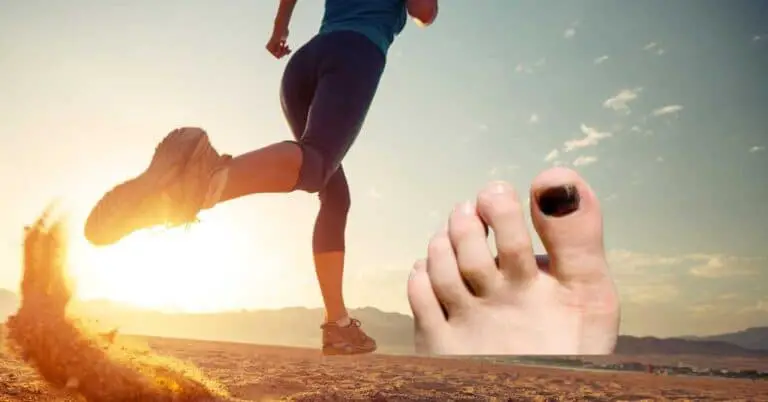Running is a great way to stay active, improve cardiovascular health, and build endurance. However, one common issue that runners often face is the dreaded black toenail. This article will explore the reasons behind this phenomenon, as well as offer useful tips and popular products to prevent and care for black toenails. Keep reading to learn how to make your toenails as happy and healthy as the rest of your body!
** I may earn a commission when you purchase through a link on this page. **
Why Running Can Turn Your Toenails Black
When you’re running, your feet are constantly subjected to repetitive pressure and impact, which can sometimes cause toenails to become black. This discoloration often results from blood blisters forming under the nail bed, which can be caused by shoes that don’t fit properly, running downhill, or simply the natural movement of your feet within your shoes. It’s important to understand the causes of black toenails to effectively prevent them.
Blood Blister Basics
A blood blister occurs when blood vessels under the skin are damaged, causing blood to pool and form a blister. This can happen in the toenail area, leading to a black toenail. Blood blisters can be painful, but they’re usually harmless and will heal on their own.
However, if you’re experiencing ongoing pain or the toenail starts to separate from the nail bed, it’s a good idea to seek medical attention from a foot care professional or practice provider.
Other Causes of Black Toenails
In addition to blood blisters, black toenails can also be caused by fungal infections, skin conditions, or trauma to the foot.
Diabetic foot care is crucial, as runners with diabetes are more susceptible to foot-related issues.
Here’s How to Reduce Your Chances of Getting a Black Toenail
- Try Silicone Toe Pads: Silicone toe pads or toe caps are a popular product among runners, as they provide a protective barrier between the toenail and the shoe. They can also help alleviate pain and prevent black toenails from forming.
- Find a Running Shoe That Fits: Shoes that are too tight or have a narrow toe box can increase the likelihood of developing black toenails. Look for running shoes with a roomier toe box and ensure they fit properly. Always try on shoes before purchasing, and consult with a specialist at a running store for guidance.
- Keep Your Toenails Cut Short: Long toenails can press against the inside of your shoes, causing pressure and pain. Keep your toenails trimmed every 3 or 4 weeks to minimize the risk of black toenails.
- Wear Good Socks: Wicking socks made from moisture-wicking materials can help keep your feet dry and prevent friction between your toes and shoes.
- Tie Your Laces Properly: Improperly tied laces can cause your foot to move excessively inside the shoe, leading to black toenails. Make sure your laces are snug but not too tight, and consider using a heel-lock lacing technique to help secure your foot in place.
- Importance of Moisturizing Toenails: Keeping your toenails moisturized can prevent them from becoming brittle and prone to breakage. It also helps maintain the overall health of your nails and surrounding skin.
- Best Type of Cream or Oil: Look for creams or oils specifically designed for nail care, such as those containing urea, lanolin, or jojoba oil. These ingredients are known for their hydrating and nourishing properties, promoting healthy toenails.
Additional Tips for Protecting Your Toenails
In addition to the primary prevention methods mentioned above, there are several other steps you can take to keep your toenails in tip-top shape while running.
These extra precautions will not only help you avoid black toenails but also ensure that your feet remain healthy and pain-free.
Let’s explore some additional tips for safeguarding your toenails and enhancing your overall running experience.
Keep Your Feet Clean and Dry
Maintaining proper hygiene is essential for healthy toenails. Wash your feet daily with mild soap and water, and be sure to dry them thoroughly, paying special attention to the areas between your toes. Keeping your feet clean and dry can help prevent fungal infections and other foot-related issues.
Rotate Your Running Shoes
Wearing the same pair of shoes for every run can cause them to wear out faster and increase the risk of black toenails. Try rotating between two or more pairs of running shoes to give each pair time to dry out and maintain its shape. This practice can also help extend the life of your shoes and provide better support for your feet.
Strengthen Your Foot and Ankle Muscles
Strong foot and ankle muscles can help prevent injuries and improve your overall running performance. Incorporate exercises like toe raises, heel raises, and resistance band exercises into your training routine to build strength in your feet and ankles. These exercises can also help prevent ankle pain and other common running issues.
Choose Proper Running Surfaces
Running on uneven or hard surfaces can increase the risk of black toenails and other foot injuries. Opt for softer surfaces like grass, trails, or a running track whenever possible. Additionally, avoid running downhill for long periods, as this can cause increased pressure on your toenails and lead to black toenails.
Seek Professional Advice on Running Techniques
Improper running techniques can contribute to black toenails and other foot problems. Consult a running coach or a physical therapist to evaluate your running form and provide personalized guidance on improving your technique. This can help you run more efficiently and reduce the risk of injury.
Regularly Replace Your Running Shoes
Over time, the cushioning and support of your running shoes can break down, increasing the risk of black toenails and other foot issues. Most experts recommend replacing your running shoes every 300 to 500 miles, depending on your running style and the type of shoes you wear. Regularly replacing your shoes ensures that you always have the proper support and protection for your feet.
Monitor and Address Foot Issues Early
Regularly inspect your feet for any signs of injury, infection, or other concerns. If you notice anything unusual, take prompt action to address the issue, and consult a healthcare provider if necessary. Early intervention can help prevent more serious problems and keep your toenails healthy and pain-free.
Conclusion
Protecting your toenails while running is an important part of overall foot care. By understanding the causes of black toenails, choosing the right shoes and socks, and practicing proper foot care, you can prevent this common issue and enjoy a more comfortable running experience.
Remember to listen to your body, and consult with a healthcare provider if you have concerns about your toenails or overall foot health. Cheers.
FAQs

Rick Huey is a fitness writer who has dedicated his life to living an active lifestyle. With more than 30 years of experience in the fitness industry, Rick is a respected contributor for FitFab50.com, where he shares his wealth of knowledge with a wide audience. His dedication to promoting the benefits of living an active lifestyle has inspired many people to pursue their own fitness journeys with enthusiasm and dedication.

